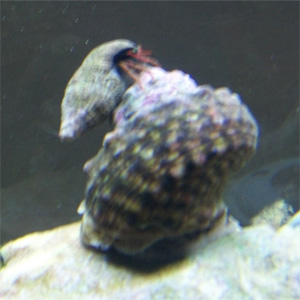One of the most frequently asked questions by new reef tank owners is, “what should should I get in my clean up crew and how many?” The clean up crew, commonly abbreviated CUC, is composed of several different types of animals, usually snails, hermit crabs, and other useful invertebrates. As the name suggests they are included in the reef tank to help clean up left over food and detritus. This article will explain the pros and cons of a CUC, suggestions for members, and stocking amounts.
Purpose of a clean up crew (CUC)
Do I need a clean up crew (CUC)
Stocking levels
Possible clean up crew (CUC) members
hermit crabs (1 per 5 gallons) – These don’t need much explanation, they eat all sorts of stuff in the tank. They eat algae, detritus, leftover food, dead fish or snails etc. Caution: as hermit crabs get larger they need to change shells. If they cannot find a shell of the proper size they will kill a snail or another hermit crab to get one. Also, not all hermit crabs are safe to put in a reef tank, only the small ones. Even these, as they get larger, may pick on corals. I’ve kept hermit crabs for years with no problems at all but some other aquarists have reported problems. Use caution.
peppermint shrimp (1 per 10 gallons) – These are actually part of the cleaner shrimp group, even though they don’t have the typical white antennae. As such they will clean fish or dead scales and parasites. They also eat the pest anemone Aiptasia. On top of that they are great at cleaning out rocks. Their long legs (with claws on the ends) can get into places a hermit crab just can’t and because they have no shell they can move easily into cracks and behind rocks.
Caution: shrimp are known to take food from corals. Some shrimp are known to pick on corals. Some fish stores will sell camel shrimp either on purpose or by mistake and call them peppermint shrimp. Camel shrimp are not reef safe and should never be put in a reef tank.
Brittle starfish (1 per 25 gallons) – These black starfish are wonderful scavengers that hide in rocks and get into crevices.
Caution: these are not to be confused with the serpent stars with are not part of a clean up crew and require much different care and cautions.
emerald crab (1 per 25 gallons) – eats algae, even bubble algae. Will also scavenge leftover food.
Caution: a crab that doesn’t have enough food will find what he can. This may include your corals. Smaller crabs are usually fine, but as they get larger this can become an issue to watch out for. I only recommend introducing emeralds if you have a bubble algae problem. They are especially fond of eating green star polyps if they are within reach.
cerith snails (1 per 5 gallons) – these are algae eaters but what makes them special is that they 1. readily breed in the tank and 2. will actually dig a little into the sand to eat algae that isn’t at the surface. This allows them to get the algae off the glass that is just under the sand where you can’t scrape it.
nassarius snails (1 per 10-20 gallons with caution) – these guys are meat eaters. They are great at cleaning up leftover food and if a fish dies you will see these guys all over it. Their most unique property is that they live under the sand and only come out to feed. I call them zombie snails because when you put food in the tank they rise up out of the sand like so many zombies! This action is not only fun to watch, but it helps keep the sand turned over and cleaner.
Caution: Nassarius are members of the welk family which is the clue to us that they should be considered with caution. If you get too many of these snails you may end up having to feed them intentionally which negates the purpose of getting them in the first place.
nerite snails (1 per 3-5 gallons) – these are algae eaters. I like them because they are very small. I keep them in my refugium. They are able to get into areas that other snails can’t get. They can also be acclimated to freshwater though they can only breed in salt.
trochus (1 per 5 gallons) – this is your underwater goat! It eats algae like crazy, especially the longer kind. It really is a lawn mower. I like it, as mentioned above, because it is smaller than the turbo, doesn’t knock things over. I really don’t feel like my tank has enough algae to keep a turbo fed so the trochus is a better fit for my tank.
turbo snail (1 per 30-50 gallons) – These large snails often starve to death. Their appetite for algae is seldom met by a low nutrient system or a well maintained tank. I only keep these if I am placing them in a very mature system with plenty of natural algae for them. If they die in your tank their size is large enough to cause major water quality issues if not removed right away. I recommend the trochus snail over the turbo in most cases.
Caution: The turbo is a wonderful snail and few snails eat algae like they do, but that also means there must be plenty of algae so these should only be purchased with caution and for the right tank.

